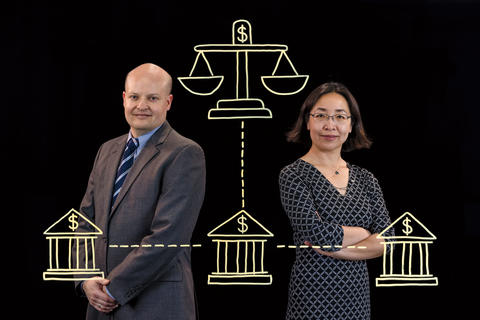
Could a ripple, not a bubble, contribute to the next financial crisis?
Wednesday, May 4, 2022
Few who lived through the Great Recession of 2008-09 need a reminder of the experience. It was, to say the least, a decidedly uncomfortable time for the American financial system, the collapse of which sent shockwaves around the world.
Regulators—and ordinary taxpayers who fronted bailout money for “too big to fail” banks—would naturally rather not repeat the ordeal.
Ever since, bank regulators (the Federal Reserve, FDIC, and the OCC) have been increasingly on the hunt for underlying risk to the financial system, especially systemic risk—the kind that can spread like a ripple.
In their recent paper, “Common Mutual Fund Ownership and Systemic Risk,” U of M Carlson School of Management Assistant Professor Michael Iselin and Associate Professor Helen Zhang, along with Scott Liao of the University of Toronto, detail an under-the-radar risk growing through the rise of common ownership of banks among passive mutual funds.
“Historically, bank regulators focused on making sure that each individual bank doesn't fail,’” says Iselin.
“Unfortunately,” says Zhang, “in past crises, you do see the pattern that banks tend to fail together."
“Because of this, regulators shifted their attention from, ‘Let's make sure that this bank doesn't fail,’” says Iselin, “to, ‘Let's try to understand how exposed this bank is to all the other banks.’”
Using data from 20,514 bank quarters from 1998 to 2018, (from 664 publicly traded banks), the researchers found that the extent of a bank’s connection with other banks via common mutual fund ownership (the ownership of multiple banks, at the same time, by the same mutual fund) increases that bank’s contribution to systemic risk—but the association was found only within passive mutual funds.
Examining this relationship is important, say the researchers.
“The tendency of one fund to hold multiple bank stocks has been going up dramatically,” says Zhang, citing research showing that in 1998, less than 4 percent of bank shares were held by mutual funds that also held other banks’ stocks—a number that had at least quadrupled by 2018.
At the same time, investor preferences for passive mutual funds—those without an individual fund manager, which mirror an index like the Dow or the S&P 500—have also rapidly increased.
While a passive fund buys and sells stocks in order to maintain alignment with its benchmark index, an active fund has a manager who makes buying and selling decisions based on an assessment of each individual stock—it’s at the fund manager’s discretion. The researchers found that this non-discretionary buying and selling nature of passive funds could contribute to herd-like movement (buy/sell) among banks when a common passive mutual fund owner faces a liquidity shock.
Additionally, because passive funds aren’t individually managed, they tend to vote on shareholder issues through proxy advisors such as Institutional Shareholder Services.
That often leads to passive funds casting one-size-fits-all votes for co-owned firms in voting decisions. Eventually, says Iselin, that can lead to an increase in the correlation of risk and failure likelihood across these banks.
“If the same mutual fund owns a bunch of different banks—particularly passive funds—they're likely to vote the same way on similar issues at these different banks,” says Iselin. “They're likely to try to impose similar types of governance mechanisms, to get similar types of people on the boards… So common ownership can make banks look more similar, react more similarly, and be similarly exposed to liquidity shocks and other risks.”
“It's a wakeup call to document this… a little bit of an unintended consequence,” says Zhang. “I don't believe that a common shareholder leading to higher systemic risk was on regulators’ radar.”
Iselin, who presented the research to the Federal Reserve Bank of St. Louis, agrees.
“The general reaction from regulators was, ‘This makes sense, but it is not something that we had previously considered.’”
